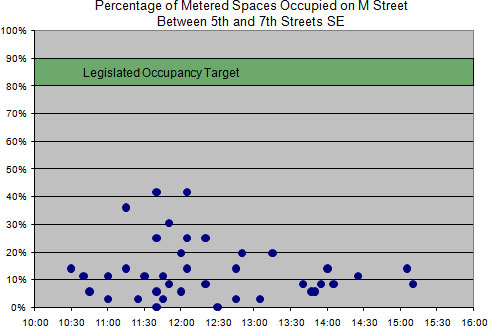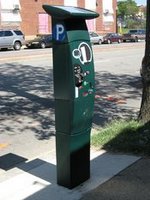M Street “performance” parking doesn’t match principles, doesn’t perform
Last March, DC implemented a pilot performance parking district near the Navy Yard metro station, the new Nationals Ballpark, and Eastern Market. Over the last two months, I’ve collected occupancy data for three blocks immediately adjacent to the Navy Yard (Google Map). Between the prices and time limitations, more spaces are going empty than needed.
Performance parking involves periodically reviewing how many cars are parked at on-street meters, then adjusting meter rates as needed. If there are too many cars parked (above 90%), then the meter per-hour price should be higher. If there are too few cars, then the meter price should be lower. The practice balances the needs of car drivers who would like to park inexpensively with those who are frustrated looking for an empty space. It’s a market-based system that tries to use prices to balance the demand for parking with the supply of on-street parking, which is essentially fixed. Properly managed, the practice also collects revenue for the city, which can be devoted to improving the local area.
Before the District installed new multispace meters, these blocks allowed three-hour (free) parking, restricted to non-rush-hours only. However, repeat out-of-state commuters typically used these spaces. Some of these same commuters parked there every single day of a two-week period.
After the District installed meters and began enforcing the time limits and rush-hour parking restriction, the streets became empty. Because one of the observed blocks had meters installed but not functioning, I was able to observe nearly identical conditions for paid parking ($1.00 for the first hour, $1.50 for each additional hour, three hours total maximum) and for free parking (identical restrictions but with no obligation to pay the meter and obtain a receipt).


Adjacent to these blocks are about 3-4 blocks worth of completely unrestricted parking, 3-4 blocks of restricted resident permit parking allowing for residents only, 3-4 blocks of RPP parking allowing visitors for up to two hours, and an all-day off street parking lot which is not completely full at a rate of $8 per day. According to JDLand, the off-street parking lot will soon be redeveloped as a high-rise apartment building.
Observations consisted of counting and recording the number of vehicles parked on the study block faces, and recording the date and time. I did not look to see whether vehicles were complying with time limit restrictions or had valid receipts showing that the meter fees had been paid. On some days, I conducted multiple observations. I attempted to spread out my observations between the hours of 10am and 3pm.
During the study days, I did not observe any paid parking more full than 42% of the allowable spaces, about half of the legislated target. If “free” parking was included from the neighboring block (the one with the non-functioning meters), parking on the study blocks was never observed more full than 59%.
Based on the observations, it appears that the parking meter rates for the study block are too high for the performance parking target. This is fairly common in the ballpark performance parking zone except for places where there is currently on-street retail, such as Barracks Row. During the lunch hour, I found full or nearly full parking near Barracks Row, and empty parking throughout the rest of the study area.
The parking restrictions in place for the study blocks contribute to low parking occupancy. The study blocks are located next to the Washington Navy Yard, a primarily office land use with few retail establishments. While there are some visitors to the area, parking in the area is generally used by all-day commuters. Restricting parking to the hours of 9:30-4pm and to three hours or less essentially reduces the market price for parking to zero.
The evidence is clear: there are still restricted spaces available even when parking is free (even the “free” block did not fill up). It’s possible that removing these restrictions would allow DDOT to charge something for parking and achieve the target occupancy rate. It’s also possible that demand is so low that what DDOT can collect won’t pay for the new multispace meters.
If the restrictions stay in place, the parking meter rates should come down, possibly to zero. In that case, DC has almost no chance of recovering the $35,000 it spent installing parking meters on the study blocks. DC can’t currently get any revenue during baseball games because game-day street parking on M Street is prohibited.
Tomorrow, I’ll discuss possible solutions as well as DDOT’s take on my observations.

